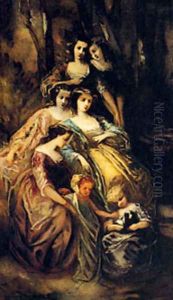Monticelli Adolphe Paintings
Adolphe Monticelli was a French painter born on October 14, 1824, in Marseille. He is known for his richly colored and densely composed paintings which prefigured the Fauvist and Impressionist movements. Despite his influence on later artists, Monticelli's work was somewhat overlooked during his lifetime, and he remained relatively obscure outside of France.
Monticelli received his initial artistic training at the École Municipale de Dessin in Marseille before moving to Paris in 1846. There, he studied under Paul Delaroche, an experience that honed his technical skills and introduced him to the academic style of painting. However, Monticelli's artistic direction dramatically shifted upon his exposure to the work of the Barbizon painters and, more importantly, the Dutch and Flemish masters he admired in the Louvre. This period was crucial in developing his distinctive style, characterized by thick impasto, vibrant color, and dynamic brushwork.
Monticelli returned to Marseille in the early 1870s, where he continued to evolve his style. His paintings from this period are noted for their fairy-tale or fantasy settings, featuring elegantly dressed figures in lush, dreamlike landscapes. These works, often small in scale, are intense in color and texture, qualities that would later influence Vincent van Gogh. In fact, van Gogh admired Monticelli's work greatly, considering him a precursor to his own exploration of color and expressive brushwork.
Despite his contributions to the development of modern art, Monticelli's work did not gain significant recognition during his lifetime. He lived modestly, and his paintings sold for relatively low prices, contributing to his financial struggles. It was only after his death in Marseille on June 29, 1886, that Monticelli's work began to be re-evaluated. Today, he is appreciated for his unique approach to color and composition, and his paintings are included in major collections worldwide, including the Louvre in Paris and the Metropolitan Museum of Art in New York.
Monticelli's legacy is that of a bridge between the traditional and the modern, demonstrating how the fervent application of color and innovative techniques can evoke emotion and atmosphere. His work continues to be studied for its impact on the artists of the late 19th and early 20th centuries, particularly for its influence on the avant-garde movements that would revolutionize art history.
